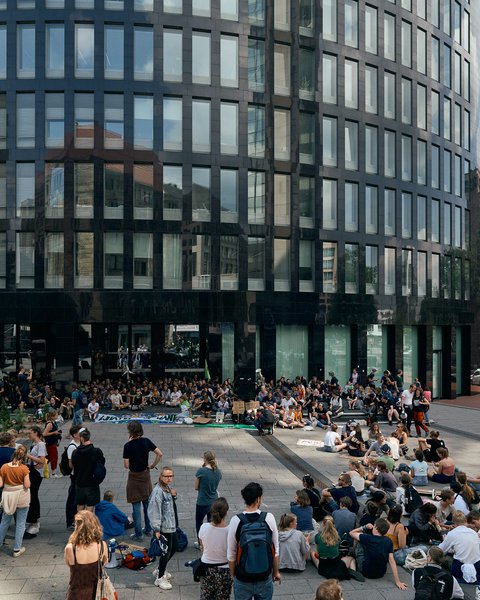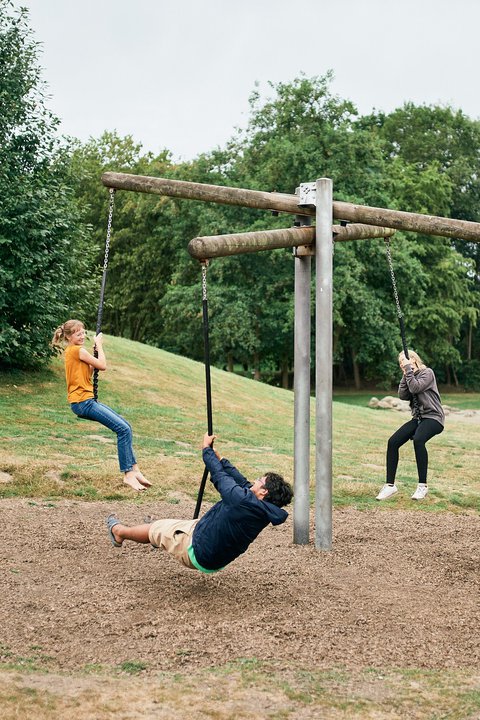My first encounter with the Vision String Quartet is unforgettable: because it was absolutely not visiual. It was at the Berlin Museum of Musical Instruments in 2017, a »dark concert«, as it will be at this the 2022 Beethovenfest in Bonn. We were given small flashlights by the organizers in case of panic, which fortunately did not occur. Instead, we experienced an evaporation and the emergence of a kind of primal experience of community.
#essay Albrecht Selge
Musical nuclear families, spirals of community

What started it all was an immediate sporting admiration for these young men who (apart from the cellist) were making music standing up, whereas we would certainly find it difficult to stand alone in the dark for long periods without making music. And then the meticulousness of the ensemble playing without eye contact! Not only in the beginnings and endings, but also in the overall fulfilment of the phrasing. But the naked respect for the athleticism of the strings soon gave way to a fascinatingly dark musical reception, new even to a habitually closed-eyed listener like myself. There seemed to be an elusive vulnerability. There was a sense of becoming one with the music you were listening to in a totally black room (but is that still a room?). Darkness as illumination. And beyond that, next to it, underneath it, interestingly enough, you also clearly felt something like a communion with the other people around you, whom you knew but neither saw nor heard, apart from the occasional soft breathing, which could also have been the sound of the spheres of the black room.

This concert community is usually a double-edged sword. The people around you can, let’s face it, disturb and annoy you. They huff, they scroll, they cough, they whisper and they scratch. The concert-goer who really, really wants to listen can end up like Christian Morgenstern’s nervous man in the meadow:
As soon as he lies down on the grass, / the ant, the grasshopper, the mosquito and the worm approach, / the centipede and the earwig come near, / and the bumblebee calls to the storm.
But simply leaving, as Morgenstern recommends, is not the answer either. And some people only really realised what they were missing without that annoying close-knit society when they were locked up in cold concerts during the pandemic. For the artists, however, the ban on socialising also affected their physical and material existence. In addition to the infamous livestreams and digital formats, to which one is forced to ascribe eminent future imperatives if one does not want to be considered narrow-minded, individual artists actually managed to strike creative sparks out of necessity: for example, Benedikt Kristjánsson, Elina Albach and Philipp Lamprecht, whose spectacularly concentrated »St John Passion« for a single voice gave rise to another primal experience. That of isolation. (From whose reflection something like community could then emerge).
Perhaps the most specialised form of musical community is the string quartet. Malicious tongues may claim that it is the bourgeois nuclear family among musical communities; in other words, depending on your point of view, the nucleus of society or a horror of intimacy. Fittingly, this type of ensemble is often based on family ties (a word to which Karl Kraus famously attributed the »flavour of truth«): Be it the Hagen siblings, be it the Schmidts in the Mandelring Quartet, whose non-family violist once confessed that he had very suspiciously thought twice about joining the tried and tested family business ... Alongside the exciting Vision String Quartet, the French Quatuor Ebène is certainly setting standards worldwide at the moment. A few years ago, Daniel Kutschinski’s documentary »4« offered a fascinating insight into the workings of this complex microcosm.

Music critics are often content to praise the »perfectly homogeneous sound« of such an ensemble of four. But this is only one facet of the string quartet, which in some ways – bourgeois nuclear family or not – forms the ideal musical community: one of unconditional individuals, not a collective. Just as hackneyed as homogeneity is the notorious Goethe-to-Zelter quote about the string quartet, or at least the first part of it. As it loses some of its crispness as it progresses, it is reproduced in full: »One hears four sensible people talking to each other, believing that they can gain something from their discourse and get to know the peculiarities of the instruments.« For visitors to many contemporary music festivals who have been tested by the various chat formats, this talk of believing they can gain something from the discourse also has a ring of truth to it ...
Of course, quartet fans from the late Beethoven to the aleatoric escapades of Lutosławski and beyond know that it is often at its most exciting when the quartet goes completely off the rails. And the »ideal community«, in the sense of free individuals working together, is today not only the string quartet, but also the instrumentation that is probably most typical of contemporary music: the flexible soloist ensemble. The Ensemble Resonanz, which will also perform at Beethovenfest, is undoubtedly one of the best.

This community of freelancers – although the term »free« for freelancers has always had a derisive connotation, not just since Corona – is not only reflected in the area of concert formats, where there is an unbroken desire to break new ground and experiment (even if some hard-working concert-goers see »innovative concert formats« as more of a threat than a promise). At the level of ensemble organisation, too, many young orchestras are breaking new ground from project to project: unbound by personal advantages and disadvantages, but always highly concentrated and without the danger of institutional routine. The young spira mirabilis – an international ensemble based in northern Italy – takes its name from the logarithmic spiral whose distance from the centre changes by the same factor with each turn. A musical nautilus shell, then, or a snail’s shell, but not one into which one can retreat. And if you start with a quartet, you end up with an octet in another loop with a factor of 2. Schubert and George Enescu wrote two of the most beautiful octets. In Bonn, the instrumentation for the »Pastorale« will be expanded once again. Whether for octet or symphony orchestra, the jointly conceived and rehearsed work will be discussed with the audience at the end of each concert (which consists of no more than this one work), in order to share the idea of interpretation.
If you were looking for the ultimate contrast to the classical concert hall, you might think of the staircase. Or it could simply be a »secret location«, revealed to the audience just before the concert, like the programme itself. This is certainly the view of the Orchester im Treppenhaus (Orchestra in the Stairwell), which has been searching for new concert perspectives since 2006. Whether the escape from the concert hall, this musical zoo (to vary the image of the museum), is successful or annoying is revealed anew with each attempt, and certainly differently for each recipient, for they too form their communities freely and flexibly. And perhaps the spiral of astonishment in the stairwell will even turn for the listener in such a way as to produce a positive vertigo effect.
This article was written for the 2022 programme book and was first published there.